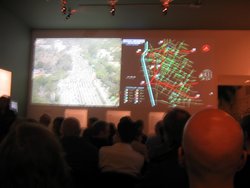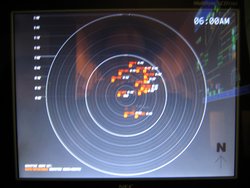Last night at the Center for Land Use Interpretation, Steve Rostam from the Automated Traffic Surveillance and Control Center (ATSAC) gave a talk on traffic management technology used in the LA area.
ATSAC is located four levels below city hall in a cold-war era complex complete with heavy swinging steel doors (“Our biggest worry is getting trapped down there if something goes wrong”). It monitors 3200 of the 4500 intersections that have traffic signals, using inductive loops and video cameras, and tries to keep traffic moving smoothly. Software written by ATSAC programmers, including an expert system, processes the data and responds by modifying signal cycle times and offsets, which they call “adaptive traffic control”.
A few points I thought were interesting:
- Despite the huge interdependence between freeway traffic and surface street traffic, ATSAC's system is not inegrated with the California Dept. of Transportation's traffic control. If turning on metering at a freeway on-ramp causes traffic to backup on nearby streets, engineers from both agencies negotiate on the phone.
- ATSAC is experimenting with processing images from video cameras to get information on congestion and vehicle speeds, but the cameras don't give any data beyond what can be had from inductive loops.
- They're experimenting with bike-specific inductive loops, and with automatic pedestrian detection using video cameras.
- Almost the only inputs to the system are from the inductive loops, which just tell you whether a vehicle happens to be directly overhead at any moment in time. The only actions taken are to alter the timing of traffic signals.
Mr. Rostam was obviously an expert and very engaged in his work, repeatedly slipping into acronymic jargon as he answered audience questions. And the audience did ask a lot of questions. “Why did you guys remove a lane at Motor and Pico? It's awful there now!” “Some people in that neighborhood really wanted to get rid of that lane, and that's their right. We ran simulations and we knew it was going to be a bad situation, but they wanted to do it anyway. Now they can't even get into their own neighborhood.”
I asked if there were any data he wished they could get and whether there were any additional actions he wished they could take to affect traffic patterns. I was a little disappointed; it seemed like something he hadn't thought about. When I asked how much room for improvement there was in the system, like, if we had God's traffic control algorithm how much faster could traffic be moving, he didn't really have an answer for that either. Oh well.
After the talk we went outside where Mr. Rostam opened up a traffic control box and showed us its guts, which was kind of neat. Precise, clean electronics inside a banged up, graffiti'd and many-times-overpainted metal box.
Posted by jjwiseman at March 20, 2004 03:45 PMI heard a story, two or three years back, about how they were experimenting with putting radio transponders in busses in L.A., so that intersections would stay keep from going red for just a second or two longer so the bus could get through. In my memory, this shaved almost a third off the transit time.
Okay, here it is, sort of: http://www.benefitcost.its.dot.gov/ITS/benecost.nsf/0/6105A5CEB6C12C9C85256DB100458915?OpenDocument&Query=State
This is a paper about giving busses that are behind schedule priority at intersections. They don't use radio transponders here, but your inductive loop detectors, because of reliability.
Posted by: Michael Hannemann on March 21, 2004 09:57 AMThe ATSAC guy did talk a little about bus-related sensing and control, and he had a bus transponder for us to look at. I know we also saw some photos of special loops cut specifically for buses.
The LA Weekly has an article[1] on the CLUI exhibit. It includes this story, which I assume is apocryphal:
"Stuck on the 405 southbound at 5:15, you might find it hard to believe that all this technology is doing anything, but Patel tells a story of an incident 15 years ago when a disgruntled councilman questioned the systemís efficacy. ATSAC simply turned off all its monitoring and control apparatus and left the lights on their default settings. In a matter of hours, the councilman was begging them to turn the system back on."
[1] http://www.laweekly.com/ink/04/17/quark-wertheim.php
Posted by: John Wiseman on March 22, 2004 09:42 AM


